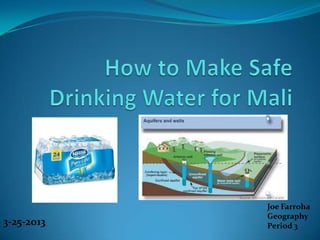
Brief History and Culture of Mali
- 1. Joe Farroha Geography 3-25-2013 Period 3
- 2. BRIEF HISTORY The Republic of Mali is a country in west Africa, formerly a French colony. As the colony of French Sudan, Mali was administered with other French colonial territories as the Federation of French West Africa. In 1956, with the passing of France's Fundamental Law (Loi Cadre), the Territorial Assembly obtained extensive powers over internal affairs and was permitted to form a cabinet with executive authority over matters within the Assembly's competence. In January 1959, French Sudan joined Senegal to form the Mali Federation, which became fully independent within the French Community on June 20, 1960. Between January and April 1992, a president, National Assembly, and municipal councils were elected. On June 8, 1992, Alpha Oumar Konare, the candidate of the Association for Democracy in Mali (ADEMA), was inaugurated as the president of Mali's Third Republic.
- 4. Interesting Facts About Mali Mali is 65% desert or semi desert Mali was under French rule in the late 19th centaury Mali gained independence in 1960. Mali is among the poorest countries in the world. Economic activity is largely confined to the riverine area irrigated by the Niger River. About 10% of the population is nomadic and some 80% of the labour force is engaged in farming and fishing. In the 1980s economic woes worsened by drought and famine led to deregulation and privatization Industry: Food processing; construction; salt and gold mining Agriculture: Cotton, millet, rice, corn; cattle Exports: Salt, Cotton, gold, livestock
- 5. All the Languages French (official language) Fifteen national languages: Bamana, Bobo, Bozo, Dogon, Juula, Fulfulde, Khassonke , Malinke, Maure, Minianka, Senufo, Soninke (or Sarakolle), Songhai (or Sonrai), Tuareg (or Tamacheq), and Tukulor
- 6. The Problem There is not enough water in Northern Mali. Less than half the overall population (46 percent) had access to potable water in 1992; the percentage is even lower (about eight percent) in the northern regions of Gao and Timbuctu. Agriculture, the cornerstone of the Malian economy, can only be practiced for a quarter of the year. Gao and Timbuctu hold the greatest share of subterranean water resources, but receive the least annual rainfall. This is a problem because the area is mostly desert.
- 7. The Agreement Mali is willing to trade ½ pound of salt for every 5 liters of purified water with Madagascar. Since Madagascar’s problem is health and food shortage, salt will preserve food to better the people’s health and solve the hunger issue. On the other hand Mali’s problem is water shortage and since Madagascar has a sufficient water source they can trade water with Mali to solve their water problem. Joe Farroha (Mali Representative) Jack Island (Madagascar Representative)
- 8. The Solution: Ways to make it possible Drill deep wells Purchase/Trade purified water from other countries Obtain water from other lakes and rivers in Mali and purify the water with chlorine dioxide tablets
- 9. Art and Music Adama Yalomba "Mbora" - Music of Mali http://search.yahoo.com/r/_ylt=A0oG7hSUck9RiDAAN SBXNyoA/SIG=120oongvm/EXP=1364189972/**http%3 a//www.youtube.com/watch%3fv=WnjcHNnPLeo
- 10. Sources http://www.mapsofworld.com/flags/mali-flag.html http://www.everyculture.com/wc/Japan-to- Mali/Malians.html http://africanhistory.about.com/od/mali/p/MaliHist1. htm http://www.aaas.org/international/ehn/waterpop/mal i.htm http://travel.nationalgeographic.com/travel/countries /mali-facts/ http://www.google.com/search?hl=en&gs_rn=7&gs_ri